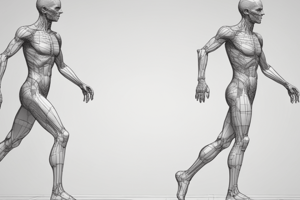Podcast
Questions and Answers
What distinguishes a pronated foot from a flat foot?
What distinguishes a pronated foot from a flat foot?
- Normal medial longitudinal arch height
- Low medial longitudinal arch with no movement through the subtalar joint (correct)
- Dynamic/functional pronation
- Presence of abduction, eversion, and dorsiflexion
In what way can a pronated foot predispose a person to certain pathologies?
In what way can a pronated foot predispose a person to certain pathologies?
- By reducing the risk of other predisposing factors
- By causing tibialis posterior overuse due to the end position of the foot (correct)
- By preventing rapid pronation of the foot
- By decreasing the load through the tendon
What is a potential consequence of a flat foot or pronated foot type?
What is a potential consequence of a flat foot or pronated foot type?
- No impact on the load through the tendon or rate of loading
- Increased risk of certain pathologies and potentially other predisposing factors (correct)
- Reduced risk of certain pathologies
- No impact on the risk of developing other predisposing factors
What distinguishes a pronated foot from a flat foot?
What distinguishes a pronated foot from a flat foot?
What is a potential consequence of having a flat foot or pronated foot type?
What is a potential consequence of having a flat foot or pronated foot type?
In what way can a pronated foot inform pathology, such as tibialis posterior overuse?
In what way can a pronated foot inform pathology, such as tibialis posterior overuse?
Flashcards
Pronated foot vs. flat foot
Pronated foot vs. flat foot
Pronated foot has abduction, eversion, and dorsiflexion through subtalar joint; flat foot has low medial longitudinal arch with no movement.
Pronated foot pathology
Pronated foot pathology
Pronated foot can cause tibialis posterior overuse due to foot's end position, leading to increased tendon loading.
Flat foot/pronated foot risks
Flat foot/pronated foot risks
Increased risk of various pathologies and possible other factors due to unusual loading patterns.
Pronated foot's role in tibialis posterior overuse
Pronated foot's role in tibialis posterior overuse
Signup and view all the flashcards
Potential consequences of flat/pronated feet
Potential consequences of flat/pronated feet
Signup and view all the flashcards
Pronated foot mechanics
Pronated foot mechanics
Signup and view all the flashcards



